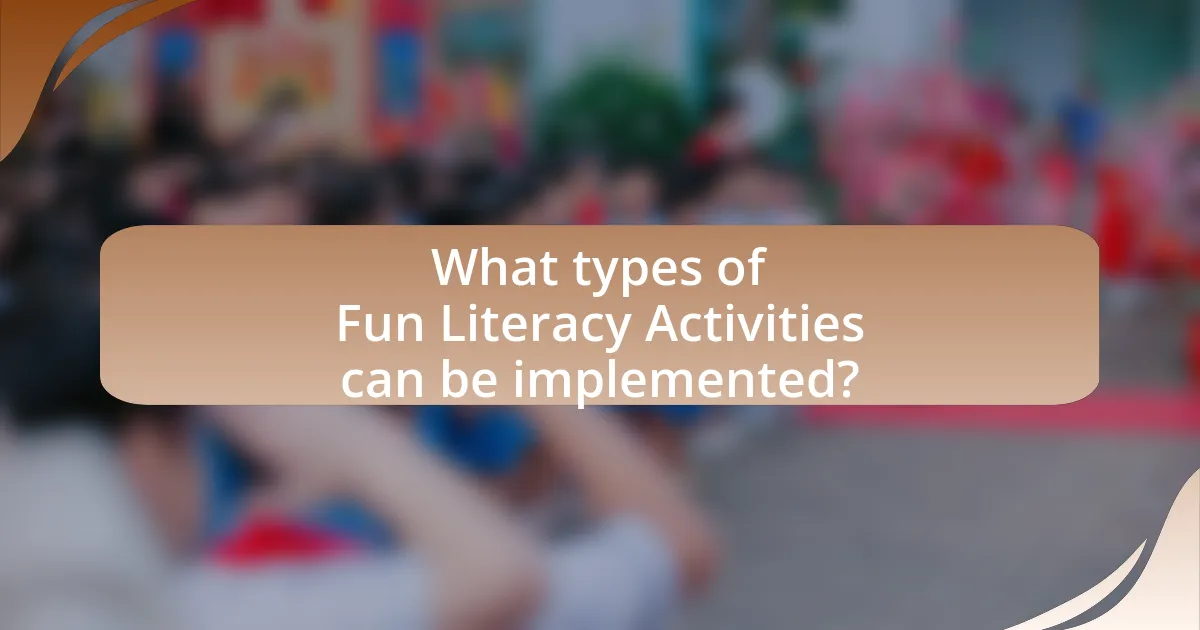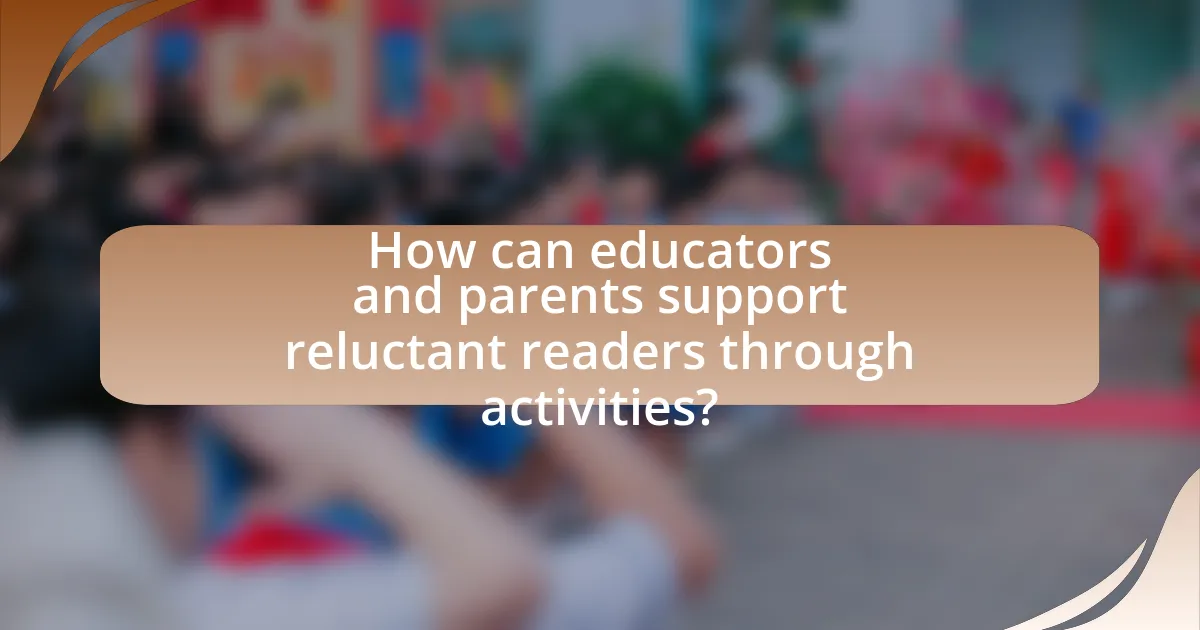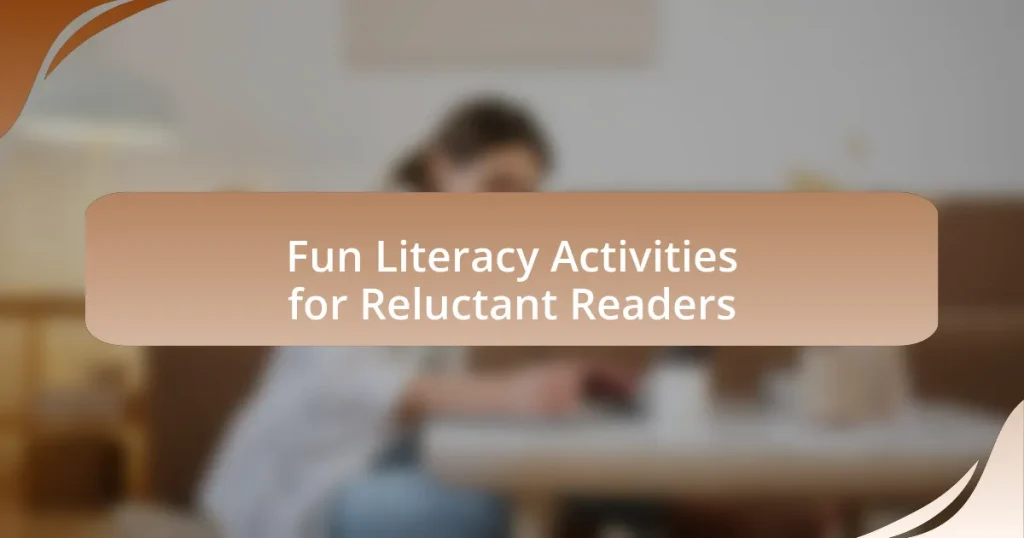The article focuses on fun literacy activities designed for reluctant readers, highlighting methods to engage them through interactive storytelling, graphic novels, and technology. It discusses the importance of creating a supportive reading environment and tailoring activities to cater to different learning styles. Key strategies include using games, hands-on activities, and personalized approaches to enhance motivation and comprehension. The article emphasizes the challenges reluctant readers face and the positive impact of enjoyable literacy activities on their reading skills and attitudes.

What are Fun Literacy Activities for Reluctant Readers?
Fun literacy activities for reluctant readers include interactive storytelling, where readers engage with the narrative through role-play or puppetry, making the experience more immersive. Additionally, using graphic novels or comic books can capture their interest due to visual elements that complement the text, making reading less daunting. Research indicates that incorporating technology, such as reading apps or audiobooks, can also enhance engagement, as these tools often provide interactive features that appeal to reluctant readers. Furthermore, creating a reading corner with comfortable seating and a variety of books can encourage a positive reading environment, fostering a love for reading over time.
How can these activities engage reluctant readers?
Fun literacy activities can engage reluctant readers by making reading enjoyable and interactive. These activities often incorporate games, technology, and creative storytelling, which capture the interest of students who may otherwise avoid reading. For instance, using graphic novels or interactive e-books can appeal to visual learners and provide a more engaging format than traditional texts. Research indicates that incorporating play-based learning strategies can increase motivation and participation among reluctant readers, as highlighted in a study by the International Literacy Association, which found that students who engaged in fun literacy activities showed a significant improvement in their reading attitudes and skills.
What types of activities are most effective for capturing interest?
Interactive storytelling and hands-on activities are most effective for capturing interest among reluctant readers. These activities engage students by allowing them to participate actively in the narrative, fostering a connection to the material. Research indicates that incorporating elements like role-playing, group discussions, and creative projects can significantly enhance engagement levels. For instance, a study published in the Journal of Educational Psychology found that students who participated in interactive reading sessions showed a 30% increase in motivation compared to traditional reading methods. This evidence supports the effectiveness of dynamic, participatory activities in stimulating interest in literacy among reluctant readers.
How do these activities cater to different learning styles?
Fun literacy activities for reluctant readers cater to different learning styles by incorporating various methods that engage visual, auditory, and kinesthetic learners. For instance, activities such as storytelling with visual aids support visual learners by providing imagery that enhances comprehension. Auditory learners benefit from read-aloud sessions and discussions, which facilitate listening and verbal engagement. Kinesthetic learners are engaged through hands-on activities, like role-playing or interactive games, that allow them to physically participate in the learning process. Research indicates that using a multimodal approach in education increases student engagement and retention, as evidenced by studies showing that students exposed to diverse instructional strategies perform better academically.
Why is it important to focus on reluctant readers?
Focusing on reluctant readers is important because they often struggle with literacy skills, which can hinder their academic success and self-esteem. Research indicates that approximately 20% of students in the United States are considered reluctant readers, meaning they show little interest in reading and may perform below grade level. By addressing their needs through targeted interventions and engaging activities, educators can help improve their reading skills, foster a love for literature, and enhance overall educational outcomes. Studies have shown that when reluctant readers are provided with enjoyable and relevant reading materials, their motivation increases, leading to better comprehension and retention of information.
What challenges do reluctant readers face in literacy?
Reluctant readers face several challenges in literacy, primarily including lack of motivation, difficulty in comprehension, and negative self-perception regarding reading abilities. These challenges can stem from previous negative experiences with reading, such as struggling with complex texts or feeling overwhelmed by the reading process. Research indicates that approximately 20% of students in the U.S. are reluctant readers, often due to a lack of engagement with traditional reading materials, which can lead to lower literacy skills over time. Additionally, reluctant readers may experience anxiety or frustration when faced with reading tasks, further hindering their progress and willingness to engage with texts.
How can addressing these challenges improve reading skills?
Addressing challenges faced by reluctant readers can significantly improve their reading skills by enhancing engagement and motivation. When specific obstacles, such as lack of interest or difficulty in comprehension, are identified and tackled through interactive and enjoyable literacy activities, readers are more likely to participate actively. Research indicates that incorporating fun elements into reading, such as games or storytelling, can lead to increased reading fluency and comprehension. For instance, a study by the National Reading Panel found that engaging activities can boost motivation and lead to better reading outcomes, demonstrating that addressing these challenges directly correlates with improved literacy skills.

What types of Fun Literacy Activities can be implemented?
Fun literacy activities that can be implemented include interactive storytelling, word games, and creative writing prompts. Interactive storytelling engages reluctant readers by allowing them to participate in the narrative, enhancing their comprehension and interest. Word games, such as Scrabble or crossword puzzles, make learning vocabulary enjoyable and can be tailored to different skill levels. Creative writing prompts encourage self-expression and imagination, making writing less intimidating and more appealing. These activities have been shown to improve literacy skills and foster a love for reading among reluctant readers, as evidenced by studies indicating that engagement in playful learning environments significantly boosts literacy development.
How can games enhance literacy skills for reluctant readers?
Games can enhance literacy skills for reluctant readers by providing engaging, interactive experiences that motivate them to read. These games often incorporate storytelling elements, requiring players to read and comprehend text to progress, which can improve vocabulary and comprehension skills. For instance, research by the Joan Ganz Cooney Center found that children who played educational games showed significant improvements in reading skills compared to those who did not engage with such games. Additionally, games that involve problem-solving and critical thinking can encourage reluctant readers to practice reading in a low-pressure environment, making literacy more enjoyable and less intimidating.
What specific games are recommended for improving reading engagement?
Specific games recommended for improving reading engagement include “Scrabble,” “Boggle,” and “Story Cubes.” Scrabble enhances vocabulary and spelling skills through word formation, while Boggle encourages quick thinking and word recognition in a timed setting. Story Cubes stimulate creativity and narrative skills by prompting players to create stories based on rolled dice with images. These games have been shown to increase motivation and enjoyment in reading activities, making them effective tools for reluctant readers.
How do games promote a positive reading experience?
Games promote a positive reading experience by engaging players in interactive narratives that enhance comprehension and vocabulary skills. Through gameplay, players encounter rich storylines and character dialogues that require reading to progress, thereby motivating them to read more. Research indicates that games like “Wordscapes” and “Scrabble” improve word recognition and spelling, as players must decode and understand words to succeed. Additionally, studies show that games can create a low-pressure environment, encouraging reluctant readers to practice reading without the fear of judgment, ultimately fostering a love for reading.
What role does storytelling play in literacy activities?
Storytelling plays a crucial role in literacy activities by enhancing engagement and comprehension among reluctant readers. It captivates their attention, making reading more enjoyable and relatable. Research indicates that storytelling fosters vocabulary development and improves narrative skills, as children are exposed to diverse language structures and contexts. For instance, a study by the National Reading Panel highlights that storytelling can significantly boost reading fluency and comprehension, particularly for struggling readers. This interactive approach not only motivates reluctant readers but also builds their confidence in literacy skills.
How can storytelling be made interactive for reluctant readers?
Storytelling can be made interactive for reluctant readers by incorporating multimedia elements, such as audio, visuals, and interactive apps, which engage different senses and enhance comprehension. For instance, using story apps that allow readers to choose plot directions or characters can motivate participation. Research shows that interactive storytelling increases engagement; a study by the University of Southern California found that students who used interactive digital storytelling tools demonstrated improved reading skills and higher motivation levels. Additionally, incorporating role-playing or dramatization of stories encourages reluctant readers to actively participate, making the experience more enjoyable and memorable.
What benefits does storytelling provide in developing literacy skills?
Storytelling enhances literacy skills by improving vocabulary, comprehension, and narrative structure understanding. Engaging with stories exposes readers to diverse language and context, which enriches their vocabulary. Research indicates that children who participate in storytelling activities demonstrate better comprehension skills, as they learn to identify main ideas and details within narratives. Additionally, storytelling fosters an understanding of narrative structure, helping readers recognize plot development and character relationships, which are essential components of effective reading and writing. Studies show that children who engage in storytelling exhibit increased motivation to read, leading to improved literacy outcomes.

How can educators and parents support reluctant readers through activities?
Educators and parents can support reluctant readers through engaging activities that promote interest in reading. For instance, incorporating interactive storytelling sessions can captivate reluctant readers by allowing them to participate actively in the narrative. Research shows that children who engage in storytelling demonstrate improved comprehension and a greater desire to read (National Reading Panel, 2000). Additionally, creating themed reading challenges, where children can earn rewards for completing books, can motivate them to explore different genres and topics. Studies indicate that gamified reading experiences significantly enhance motivation and reading frequency among children (Guthrie & Wigfield, 2000). Furthermore, providing access to graphic novels and audiobooks can cater to diverse interests and learning styles, making reading more appealing. By utilizing these activities, educators and parents can effectively foster a love for reading in reluctant readers.
What strategies can be used to create a supportive reading environment?
To create a supportive reading environment, strategies include establishing a comfortable and inviting space, providing diverse reading materials, and incorporating interactive reading activities. A comfortable space with adequate lighting and seating encourages longer reading sessions, while diverse materials cater to various interests and reading levels, making reading more appealing. Interactive activities, such as reading aloud or book discussions, foster engagement and build a community around reading. Research indicates that environments rich in resources and social interaction significantly enhance reading motivation and comprehension among reluctant readers.
How can parents encourage reading at home?
Parents can encourage reading at home by creating a reading-friendly environment and engaging in interactive reading activities. Establishing a designated reading space with comfortable seating and good lighting can make reading more appealing. Additionally, parents can read aloud to their children, which has been shown to improve literacy skills and foster a love for books. According to the National Institute for Literacy, children who are read to regularly develop better vocabulary and comprehension skills. Incorporating a variety of reading materials, such as books, magazines, and comics, can also cater to different interests and keep children motivated to read.
What resources are available for educators to implement these activities?
Educators can access a variety of resources to implement fun literacy activities for reluctant readers, including online platforms, educational websites, and community programs. Websites such as ReadWriteThink and Scholastic offer lesson plans, interactive tools, and engaging activities specifically designed to enhance literacy skills. Additionally, local libraries often provide free workshops and reading programs that encourage reluctant readers to participate in literacy activities. Research indicates that interactive and engaging resources significantly improve reading motivation and skills among reluctant readers, as highlighted in studies by the National Reading Panel.
What are some best practices for implementing literacy activities?
Best practices for implementing literacy activities include creating a supportive environment, incorporating diverse materials, and using interactive methods. A supportive environment encourages participation and reduces anxiety, which is crucial for reluctant readers. Diverse materials, such as graphic novels, audiobooks, and digital resources, cater to different interests and learning styles, making reading more appealing. Interactive methods, like group discussions and hands-on activities, engage students actively, fostering a love for reading. Research shows that these strategies can significantly improve literacy skills and motivation among reluctant readers, as evidenced by studies indicating increased engagement and comprehension when varied approaches are utilized.
How can activities be tailored to individual interests and needs?
Activities can be tailored to individual interests and needs by assessing each reader’s preferences, strengths, and challenges. For instance, incorporating themes from a reluctant reader’s favorite books or hobbies into literacy activities can enhance engagement and motivation. Research indicates that personalized learning approaches, such as differentiated instruction, significantly improve reading outcomes by catering to diverse learning styles and interests. A study by Tomlinson (2001) highlights that when educators adapt tasks to align with students’ interests, it fosters a more meaningful learning experience, ultimately leading to increased participation and improved literacy skills.
What common pitfalls should be avoided when engaging reluctant readers?
Common pitfalls to avoid when engaging reluctant readers include using overly complex texts, which can discourage interest and comprehension. Research indicates that texts should match the reader’s skill level to foster engagement; for instance, the National Reading Panel emphasizes the importance of appropriate reading levels for motivation. Additionally, forcing reluctant readers to read materials they find uninteresting can lead to negative associations with reading. Providing choice in reading materials has been shown to increase motivation, as highlighted in studies by the International Literacy Association. Lastly, neglecting to incorporate interactive and enjoyable activities can diminish enthusiasm; engaging methods such as storytelling or gamified reading experiences have proven effective in capturing reluctant readers’ attention.
What practical tips can enhance the effectiveness of literacy activities?
Incorporating interactive elements into literacy activities significantly enhances their effectiveness. Engaging reluctant readers through games, storytelling, and hands-on activities fosters a more enjoyable learning environment, which can lead to increased motivation and participation. Research indicates that interactive literacy practices, such as using technology or group discussions, can improve comprehension and retention rates among students. For instance, a study published in the Journal of Educational Psychology found that students who participated in interactive reading sessions showed a 30% increase in reading comprehension compared to traditional methods.










